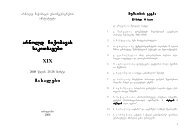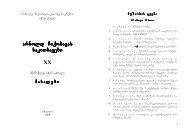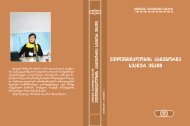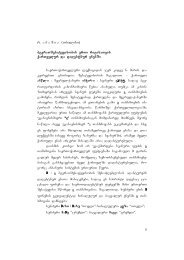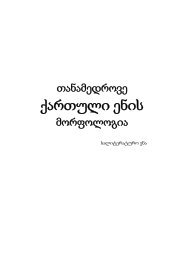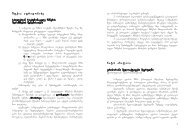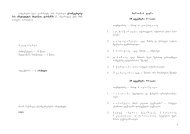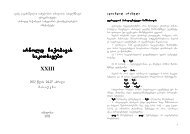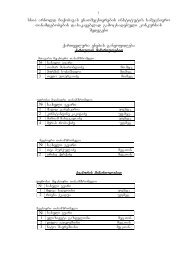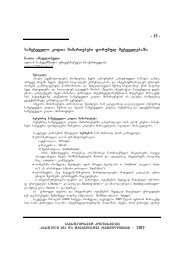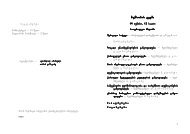iberiul-kavkasiuri enaTmecniereba XXXIX
iberiul-kavkasiuri enaTmecniereba XXXIX
iberiul-kavkasiuri enaTmecniereba XXXIX
You also want an ePaper? Increase the reach of your titles
YUMPU automatically turns print PDFs into web optimized ePapers that Google loves.
116<br />
r. lolua<br />
feature of prosody and is spread in all word. According to S. Kodzasov's viewpoint, a<br />
pharyngealization pick comes on the first syllable (i. e. vowel), but if in a word there is<br />
a hushing, uvular and pharyngeal consonant, then maximum of pharyngealization<br />
comes on it.<br />
According to my observation, this viewpoint should be shared. Specialists' recordings<br />
speak about the fact, that in Udi pharyngealization comes on whole word: a<br />
number of the lexemes with two-and more syllables, where according to researchers'<br />
viewpoint, all vowels occur as pharyngealized, is large. The cases often occur, when<br />
pharyngeal vowels are marked in such word-forming elements and affixes, in which,<br />
separately, there is a simple vowel. It should be noted, that according to researchers'<br />
recordings, in Udi pharyngealized vowels are not attested in affixes (as it was mentioned<br />
there are alternation of simple and pharyngealized vowels). It is natural, that this<br />
does not speak in favor of phonemity of pharyngealized vowels. The mentioned situation<br />
should be caused by the fact, that in Udi in a word the maximum of pharyngealization,<br />
as it was mentioned, comes on an initial vowel, or initial pharyngeal, uvular or<br />
hushing consonant and prefixation is almost broken.<br />
Alternation of pharyngealized and non-pharyngealized graphical variants in affixes<br />
points to the fact, that in Udi pharyngealization is a feature of prosody. Affixes are just<br />
those entries which are morphologically connected with a stem and it is clear, that in<br />
these elements pharyngealization is defined by other entry (or a stem).<br />
Frequent alternation of pharyngealized vowels is noteworthy, when the cases of<br />
pharyngealized alternation are noticeable with non-corelete simple vowels. There are<br />
cases, when a simple vowel assimilates a pharyngealized vowel and as a result of this it<br />
gains pharyngealizity. It also points to the fact, that in Udi the pharyngealization process<br />
is not a segmentic feature of a vowel.<br />
In special literature there were several attempts to confirm the phonemicity of<br />
pharyngealized vowels. I think, in Udi generally pharyngealization and not any pharyngealized<br />
sound – a vowel or a consonant has a distinctive function.<br />
As it is clear pharyngealization was characteristic of common Lezgian. The existance<br />
of identic sound-cornespondences among the Lezgian languages from the pharyngealization<br />
standpoint points to it. There are cases, when a pharyngeal vowel evidenced<br />
in the Lezgian and Dagestanian languages is lost in Udi; but instead of it there occurs<br />
pharyngealization. It makes me to think, that in Udi pharyngealization is a compensative<br />
process, that is caused by weakening, loosing or moving in other consonants of<br />
pharyngeal consonants.<br />
To my opinion, an issue of so called intensive consonants in Udi is connected with<br />
pharyngealization. This is supported by the fact, that in most cases intensives are attested<br />
in one word at pharyngealized vowels. During comparing the researchers, materials<br />
this is supported by the cases of alternation of pharyngealized vowels and intensive<br />
consonants.<br />
It should be noted that some contemprorary researchers (T. Maisak, V. Schulze in<br />
Udi verify not intensive, but velarized hushing consonants. Velarization of hushing, that<br />
gives consonants different tembre, should be discussed as accompanying process of<br />
pharyngealization. I believe, that just relevant process of pharyngealization/velarization<br />
of hushings misleaded those researchers, who assume intensive consonants in Udi phonological<br />
system. I think, that distinguishing of velarized phonemes in Udi is not correct.



